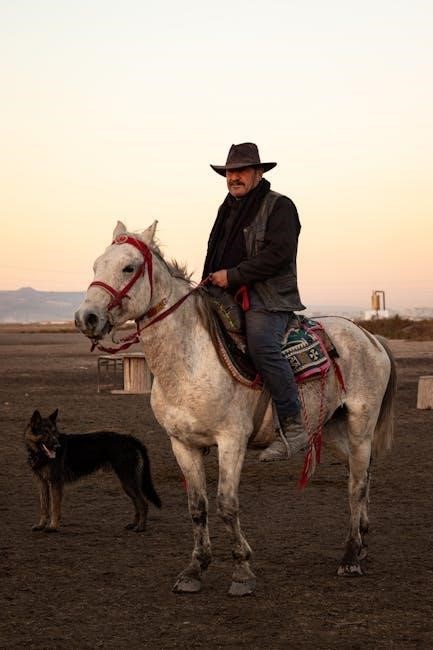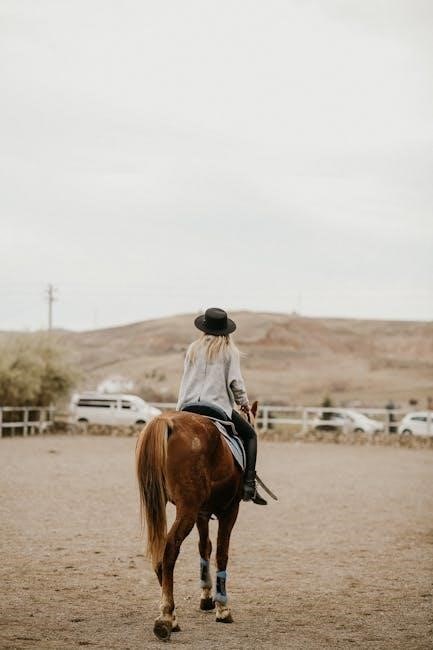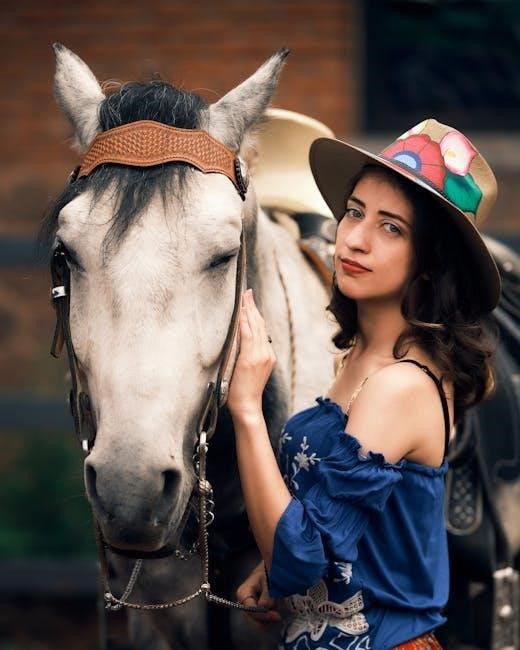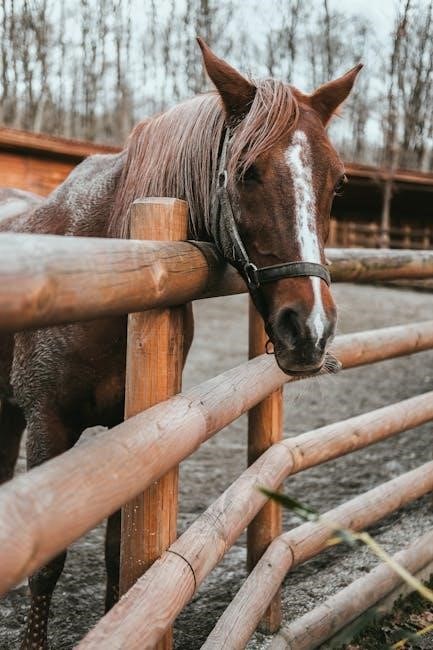Proper saddle fit is crucial for both horse and rider comfort. Measure the horse’s wither, back, and gullet width to determine the right tree size. The rider’s seat size should allow 2-4 inches of space between the thigh and pommel. Always test the saddle on the horse and consider visiting a tack shop for expert fitting.
A Western saddle is a type of saddle designed for comfort and durability during long rides, often used in trail riding, ranch work, and specific equestrian disciplines. Unlike English saddles, Western saddles feature a prominent horn, a cantle, and a sturdy tree, which provides structural support. Proper sizing is essential to ensure both the horse and rider experience optimal comfort and performance. A well-fitted saddle prevents discomfort, injury, or long-term damage to the horse, while also allowing the rider to maintain balance and control. The sizing process involves measuring both the horse and the rider, as well as understanding the saddle’s key components, such as the tree, gullet, and seat size. Incorrect sizing can lead to issues like uneven weight distribution, restricted movement, or even behavioral problems in the horse. This guide will walk you through the critical aspects of Western saddle sizing, helping you make an informed decision for you and your equine partner.
Key Components of a Western Saddle
A Western saddle is built with several essential components that contribute to its functionality and fit. The saddle tree is the internal framework that provides structural support and determines the saddle’s shape and size. It is typically made of wood, fiberglass, or composite materials and features bars that must fit the horse’s back. The gullet is the space between the bars of the tree, measuring the width of the saddle’s spine, crucial for accommodating the horse’s spine. The seat is where the rider sits, with its size measured from the button (pommel) to the center of the cantle. The pommel and cantle are the front and back parts of the saddle, respectively, providing support and stability. Skirts cover the tree, and the horn is used for dallying ropes in ranch work. Understanding these components is vital for selecting a saddle that fits both the horse and rider properly, ensuring comfort and performance.
Measuring the Horse for Saddle Fit
To ensure proper saddle fit, measuring the horse is essential. Start with the wither tracing method: place a flexible measuring tape or string along the horse’s withers, tracing the natural curve of the spine. This helps determine the gullet width, a critical measurement to prevent pressure on the horse’s spine. Next, measure the length of the horse’s back from the withers to the last rib, ensuring the saddle’s skirts won’t interfere. Use a soft tape measure to assess the wither height and shoulder angle, as these influence the saddle’s tree angle. The gullet width should be at least 2-3 inches wider than the horse’s spine to allow freedom of movement. Regularly remeasure, as horses’ muscle development and back length can change over time. Accurate measurements ensure the saddle fits comfortably, promoting both horse and rider performance. Always use a trained professional or detailed guides for precise results.
Determining the Rider’s Seat Size
To determine the rider’s seat size, start by sitting comfortably in the saddle with your feet in the stirrups. A proper fit allows about 2-4 inches of space between your thigh and the pommel. Measure from the center of the cantle to the button on the pommel to find the seat size in inches. Ensure the saddle feels balanced, with your weight evenly distributed and your shoulders, hips, and heels aligned. The cantle should not dig into your back, and you should avoid overcrowding the seat. Rider height, weight, and personal comfort also influence seat size. For example, taller riders may prefer a larger seat for support, while shorter riders need a smaller size to maintain control. Test the saddle in person and consider expert fitting to ensure optimal comfort and performance. Remember, proper seat sizing enhances both rider confidence and horse responsiveness. Always prioritize a snug yet comfortable fit tailored to your riding style and preferences.
Types of Western Saddles and Their Sizing Considerations
Western saddles come in various styles, each designed for specific purposes, and their sizing varies accordingly. A Reining saddle is lightweight with a smaller seat, ideal for agility and control. A Trail saddle offers a larger seat and more padding for comfort during long rides. Roping saddles have a sturdy design with a stronger tree and wider gullet to accommodate larger horses. Barrel racing saddles are compact, with a flatter seat for quick movements. When choosing a saddle type, consider your riding discipline, horse breed, and personal preferences. For example, a Quarter Horse may require a narrower tree, while a larger breed like a Warmblood needs a wider tree. Sizing also depends on the saddle’s bars and skirt length, which should complement the horse’s back length. Always ensure the saddle’s features align with your horse’s conformation and your riding needs for optimal fit and performance. Proper sizing ensures comfort and effectiveness for both horse and rider in their specific activities.

The Role of the Saddle Tree and Gullet Width
The saddle tree is the internal framework of the saddle, determining its shape and size. It plays a critical role in distributing the rider’s weight evenly across the horse’s back. A properly fitted tree ensures comfort and prevents pressure points. The gullet width, measured as the space between the two sides of the tree, must match the horse’s wither and back shape. A gullet that is too narrow can cause discomfort, while one that is too wide may not provide adequate support. The tree’s angle and bars should align with the horse’s ribcage and shoulder movement. Different horse breeds or body types may require specific tree styles, such as a “narrow” or “wide” tree. Regularly checking the fit of the tree and gullet is essential, as horses’ shapes can change over time. A well-fitted saddle tree and gullet width ensure both horse and rider can move freely and comfortably, promoting performance and long-term health.

Measuring the Saddle
Measuring a western saddle accurately is essential to ensure proper fit for both the horse and rider. Start by determining the seat size, which is measured from the center of the cantle to the button on the pommel. This measurement ensures the rider has adequate space, typically 2-4 inches between the thigh and the pommel. Next, measure the gullet width, the space between the two bars of the saddle tree, to ensure it matches the horse’s wither and back shape. The skirt length should also be considered to prevent interference with the horse’s movement. Additionally, the bars of the saddle tree, which come in various widths, should align with the horse’s ribcage and shoulder structure. Proper measurement ensures the saddle distributes weight evenly, avoiding pressure points. Always test the saddle on the horse and consider professional fitting for optimal comfort and performance. Accurate measurements guarantee a harmonious fit for both rider and horse.
Common Mistakes in Saddle Sizing
One of the most common mistakes in saddle sizing is assuming the same size applies across different brands or types of saddles. Western saddles, for instance, often run smaller than English saddles, so a rider who fits a 17-inch English saddle may need a 15-inch Western saddle. Another error is neglecting to measure the horse’s wither and back length, leading to a saddle that either sits too far forward or doesn’t provide enough support. Riders also often overlook the importance of gullet width, which must match the horse’s conformation to prevent discomfort or injury. Additionally, some riders focus solely on the seat size without considering the overall balance of the saddle, which can affect both their position and the horse’s movement. Finally, not testing the saddle on the horse before purchase is a frequent oversight, as even a correctly measured saddle may not fit properly due to the horse’s unique shape. Avoiding these mistakes ensures a better fit and improved comfort for both horse and rider.

Impact of Saddle Pads and Cinches
Saddle pads and cinches play a critical role in achieving optimal saddle fit and comfort for both the horse and rider. A well-fitted saddle pad provides cushioning, protects the horse’s back, and helps distribute the saddle’s weight evenly. It also prevents friction and absorbs shock, enhancing the horse’s comfort during long rides. Cinches, on the other hand, secure the saddle in place and ensure proper positioning. A correctly fitted cinch should neither be too tight nor too loose, as this can lead to discomfort or restricted movement for the horse. The material and style of the cinch, such as neoprene or traditional fleece, can also impact the overall fit and performance. Using the right saddle pad and cinch combination not only improves the horse’s well-being but also ensures the saddle stays in place, allowing the rider to maintain balance and control. Properly selecting and fitting these accessories is essential for a harmonious riding experience.
Adjusting the Saddle for Fit
Properly adjusting the saddle ensures both horse and rider comfort. Start by placing the saddle on the horse’s back, positioning it slightly forward, then sliding it back to the correct spot, ensuring it sits behind the withers. The cinch should be tightened gradually, starting from the front, to avoid discomfort. Use a saddle pad to fill gaps and provide extra cushioning. Check the saddle’s balance by ensuring the pommel and cantle are level. If the saddle tips forward or backward, adjust the padding or cinch position. After riding, inspect the horse’s back for even sweat patterns, indicating proper fit. Regularly recheck the saddle’s fit as the horse’s condition or workload changes. Fine-tuning these adjustments ensures optimal comfort and performance for both horse and rider.
Final Tips for Optimal Fit

Achieving the perfect fit requires attention to detail and regular adjustments. Always measure the horse’s back and the rider’s seat size accurately to avoid sizing errors. Consider the horse’s breed, age, and workload, as these factors can influence saddle fit. Use a wither tracing or professional guidance to ensure proper alignment. Ensure the saddle pad fills gaps and provides even pressure distribution. After riding, inspect the horse’s back for uniform sweat patterns, indicating correct fit. Adjust the cinch and saddle position periodically, especially during long rides. Keep in mind that saddle fit may change over time due to the horse’s muscle development or weight fluctuations. Finally, never underestimate the value of expert advice; visiting a reputable tack shop can provide personalized recommendations. By following these tips, you can ensure a comfortable and performant fit for both horse and rider, promoting long-term health and enjoyment.

Leave a Reply
You must be logged in to post a comment.